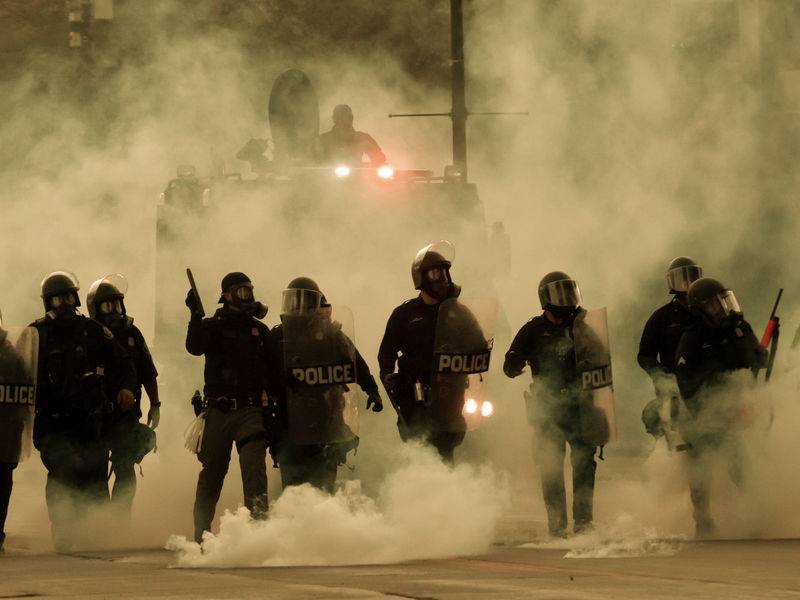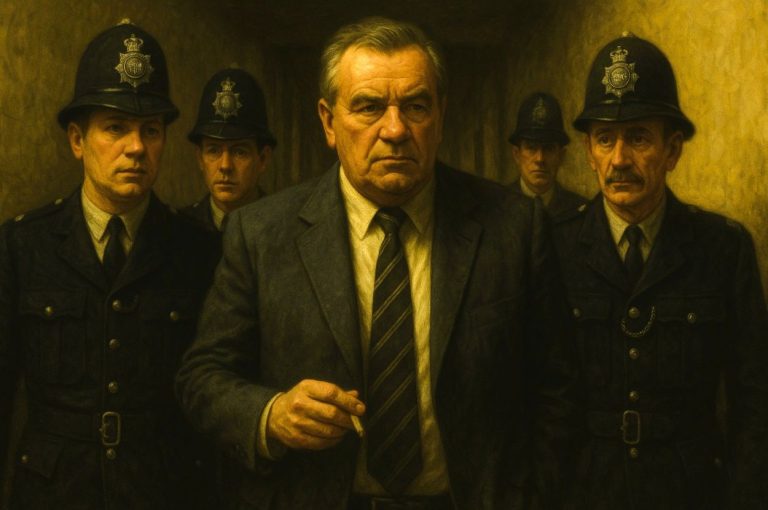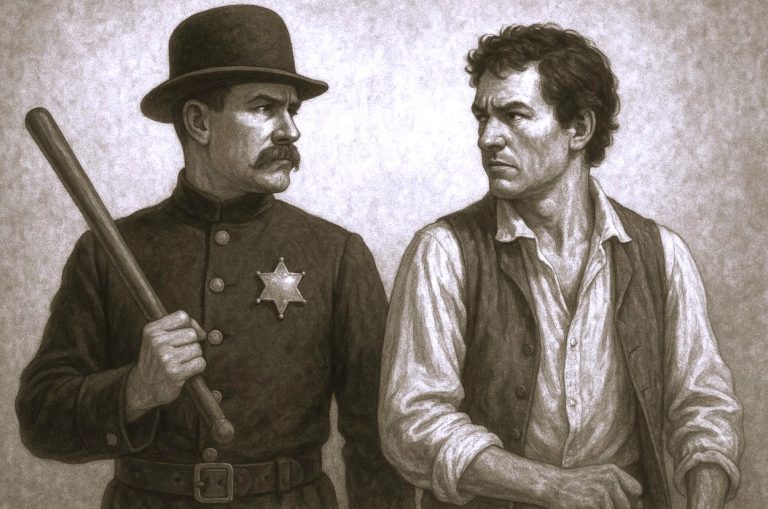

Academic conversations around defunding or abolishing the police have been around for decades, but now, some politicians are opening up to such notions.
By Talia Buford, Lucas Waldron, Moiz Syed, and Al Shaw
The Experts
Rohini Haar, MD
Emergency Room Doctor, Kaiser Medical Center
Consultant, Physicians for Human Rights
Adjunct Professor of Epidemiology, University of California, Berkeley

Dr. Haar is an emergency room doctor, adjunct professor at the University of California, Berkeley, and consultant for Physicians for Human Rights, where she has studied the health impacts of crowd-control weapons. Haar assesses use of force through guidelines set by the United Nations in 1990, which recommend police use “force to the minimum extent necessary.”
Frank Straub, PhD
Director, Center for Mass Violence Response Studies
National Police Foundation

Straub, a former police chief in Spokane, Washington, is director of the Center for Mass Violence Response Studies at the NPF and a 30-year veteran of law enforcement. He has led reviews for the Department of Justice and police departments after shootings and other major events. Straub said the onus is on the police to use only the amount of force necessary to protect themselves and others.
The Videos
Washington, D.C. • June 1, 2020
In a protest near the White House, a protester throws a water bottle at police. Soon after, an officer rears back to throw an explosive device at the crowd. The device appears to be a grenade, containing rubber pellets and smoke. The grenade explodes inches from a protester, showering him in sparks and smoke. Several agencies deployed officers to this protest, including the U.S. Park Police, which has primary responsibility for the park surrounding the White House. The Park Police would not say if the officer shown is a member of the agency.
Haar said that the use of this kind of grenade did not seem proportional to the threat.
“Getting a water bottle thrown when you’re in full riot gear with a shield doesn’t justify the use of essentially a weapon.”
Straub said that police officers shouldn’t be expected to determine what’s being thrown at them before responding.
“If you’re standing there in that skirmish line, and somebody’s throwing something at you, is it really up to you to be figuring out whether it’s gasoline or whether it’s metal, or whether it’s water or whether it’s acid?”
Experts said how police respond to demonstrations is, in part, dictated by the availability of nonlethal weapons and on how officers are trained to use them.
In 2016, Haar surveyed 25 years of research on crowd-control weapons used around the world, including three commonly used in the United States: projectiles such as rubber bullets or beanbag rounds; chemical irritants such as tear gas; and disorientation devices known as flashbangs. Her report found that when fired, tear gas canisters can cause vision loss or other traumatic injuries.
“These are all weapons that should be used as a last resort when open dialogue and communication fail and the violence is so out of hand that normal policing methods and arresting people have been tried and don’t work,” Haar said.
The size of protests also influences how police respond, Straub said. Small protests can likely be handled by specialized units that are regularly tasked with managing crowds. Larger protests may require many more officers, some of them drawn from parts of police departments that have less experience and training in crowd control and de-escalation, and thus may be more likely to resort to weapons.
In the Washington video, by not rushing the crowd when a protester threw a bottle, Straub said, the officers remained calm and acted with “restraint.” It would be unfair, Straub said, to require the police to analyze what protesters are throwing at them before reacting, given how quickly such an encounter could escalate. “One person throws a water bottle, five people throw water bottles, and then somebody throws a brick,” he said.
Experts said how quickly officers choose to deploy weapons in the field depends on their training, which can vary widely between departments.
No entity sets training standards for police use of force, experts said. However, departments, equipment manufacturers and state officials have mandated that officers undergo training before they are allowed to use nonlethal weapons. Depending on the training, officers may be taught how to shoot weapons so they “skip off the pavement” in order to decrease their velocity and risk of serious injury.
In firing their guns, officers are taught to aim at the person’s torso because it reduces the risk that a bystander will be struck. But with nonlethal weapons, officers are often instructed to avoid the torso, head or groin, said Thor Eells, executive director of the National Tactical Officers Association, a trade group for SWAT teams that also conducts training for police departments. Precise aim in a crowd is extremely difficult, he said.
“We explain to them that in a crowd control situation, it’s a dynamic environment,” Eells said. “It’s not the same as a paper target.”
Los Angeles • May 30, 2020
A Los Angeles Police Department officer pushes into the crowd. Another officer starts hitting protesters with a baton. LAPD’s policy is to use batons as a pushing tool. Officers are not supposed to strike an individual unless the person is behaving violently. At some point, an officer ends up on the ground. Officers continue beating protesters with batons. The LAPD said the incident was under investigation.
Haar said that LAPD regulations are clear that batons should primarily be used to push back, and if they are used to strike people they are likely to cause injuries.
“Police have said to me things like, ‘Well, you know, if they don’t give us tear gas, then we’ll go back to batons,’” she said. “It strikes me this is why we need regulation of all of these weapons, including the use of force, because batons are so dangerous, especially against peaceful protesters.”
Though video doesn’t show when the officer fell, Straub said an officer on the ground would immediately move other officers into “protection mode.”
“Could there have been a different way, a better way? Maybe,” Straub said. “But, you know, I’m sure they’re in fear for the safety of that officer at this point.”
Managing large crowds and protests has long been part of policing, from the civil rights movement and the Vietnam War to the wave of recent demonstrations against police brutality. How police carry out that duty, however, often comes down to who an officer views as a threat.
Michael Sierra-Arévalo, a University of Texas at Austin sociology professor who focuses on police behavior, said officers are taught to view every situation as “full of risk, full of potential violence.” That framing, he said, which stresses control to stave off “catastrophic” yet unlikely outcomes, can often result in the rationalization of excessive force.
“In protests, you see cases where officers are engaged in a self-fulfilling prophecy,” Sierra-Arévalo said. “We know that when you show up with that kind of equipment, it can escalate. You don’t even have to use the equipment. You show up ready for war, and the stakes have now changed.”
It’s impossible to view that escalation without taking race into account. Armed white protesters upset about coronavirus mask requirements massed at the Michigan State Capitol, yelling in the faces of officers who stood calmly at attention. Meanwhile, protesters of all races marching against police brutality against Black people were met with shocking uses of force.
Monica Bell, a Yale law and sociology professor who has studied police response to protests in Baltimore and Ferguson, Missouri, said that the government constantly sends messages that Black people are “really not a part of the body politic.” When it comes to protests against police brutality, the message that Black people are not afforded the same liberties and protections applies to any protester — regardless of their race — marching alongside them, she said.
“It’s never just about the violence of that moment,” she said. “It is about the longer story of racialized violence and American policing.”
Denver • May 30, 2020
Someone behind the camera throws a water bottle at police while they are driving away. This officer raises a PepperBall gun. The red laser is the gun’s scope. Then the officer shoots the person holding the camera in the face. The Denver Police Department prohibits shooting anyone in the head with a PepperBall, except in situations where lethal force would be necessary. The Denver Police Department said the incident is under investigation.
Haar said that she could not see any reason to justify shooting a PepperBall at the head of an unarmed protester.
“There’s no necessity, there’s no purpose,” she said. “What’s he doing? He’s just firing it for fun.”
Haar said that PepperBalls pose a high risk of injury when they are shot at close range and aimed at the face.
Straub was critical of the officer’s actions. He said that it did not appear that anyone was obstructing the officers’ ability to drive away. “It doesn’t seem like there’s really any reason” to fire at the crowd, he said, adding that there was no apparent danger of the police being overrun.
In dozens of videos, officers’ decisions to escalate violence seemed to come out of nowhere, catching crowds off guard.
In Denver, the use of force policy allows nonlethal weapons like guns that shoot balls filled with chemical irritants to be used on an individual or “when ordered by a … command officer in crowd control or riot situations,” but it says nothing about using the weapon when leaving a crowd.
Under most police department guidelines, an officer has to have a basis for firing such weapons, said Brian Higgins, a retired Bergen County, New Jersey, police chief and an adjunct professor at John Jay College of Criminal Justice in New York.
“I have to have a justifiable reason for that use of force,” he said. “I can never just fire the round.”
Sometimes, the police justification for confronting protesters is that the protest has been deemed unlawful. That allows officers to use nonlethal force to disperse crowds or arrest protesters, Higgins said, even if they are demonstrating peacefully.
Experts said that ideally the line between unlawful and lawful — peaceful or not — has been decided and communicated to the demonstration organizers beforehand. But often, experts said, the decision is made as senior commanders communicate with officers on the ground, and the police may err on the side of intervening if they see a single person acting out even if everyone else is following the rules.
Bell, the Yale professor, said deeming protests violent or unlawful when police disapprove of the grievances is common.
“What’s going on,” she said, “is police deploying various forms of force to tamp down dissent.”
New York • May 30, 2020
A protester is standing with his hands up when an officer pulls down the protester’s mask. Then the officer discharges pepper spray into the protester’s face. The NYPD said the officer in this video has been suspended without pay.
Haar said the clip had “so many layers of inappropriate use of force”: the spray wasn’t necessary since protesters had their hands up, and the use wasn’t “proportional, even if he was heckling you.”
She said any amount of pepper spray in the face would cause the person to cough, creating a public health risk in the midst of a pandemic.
“This shows an intentional and kind of cruel use of force for no reason.”
Straub said it was hard to see what the dynamic was in such a short clip, but he said the officer used a “fairly judicious” amount of pepper spray. Still, he questioned the officer’s decision to pull the protester’s face mask down.
“If you’re going to spray somebody, there’s really no reason to touch them,” he said.
Law enforcement experts stressed that viral protest videos, while visceral, only show a moment in time and may miss what officers were facing outside of the frame. To account for that, ProPublica excluded from its analysis any videos that purported to show the aftermath of brutality but failed to capture police actions or context on tape.
Additionally, experts noted the stress that officers face from encountering openly hostile crowds, working long hours of overtime and dealing with the threat of being killed or otherwise targeted while at protests.
“In these highly emotional, highly energetic processes,” Straub said, “we’ve seen people that have acted outside the boundaries of what they’re taught and trained to do.”
Reaction to police escalation caught on video has been swift.
As demonstrations continued and the media drew attention to the police tactics, departments in at least 40 cities have announced changes. In Philadelphia, officials announced a moratorium on tear gas to control crowds, New York moved to make officers’ disciplinary records public, San Francisco announced plans to stop sending police officers to calls that don’t involve criminal activity and Atlanta now requires officers to intervene if they see another officer using unreasonable force.
Straub said that the scrutiny of officers’ actions in protests, and the condemnation of George Floyd’s killing in Minneapolis, were strong signals “that that kind of behavior isn’t going to be tolerated.”
Meanwhile, academic conversations around defunding or abolishing the police have been around for decades, but now, some politicians are opening up to such notions. That’s in part, Bell said, because of the “intellectual organizing” Black Lives Matter activists did early on to help frame the injustices they were protesting.
“Now, the real question about whether this time will be ‘different’ also has to do with what’s adopted,” Bell said.
Originally published by ProPublica, 07.16.2020, under a Creative Commons Attribution-NonCommercial-NoDerivs 3.0 United States license.


